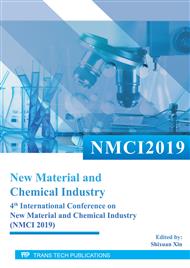p.3
p.10
p.16
p.22
p.28
p.36
p.47
p.55
Effect of TBPF Microencapsulated Ammonium Polyphosphate on the Properties of Thermoplastic Polyurethane Elastomer
Abstract:
In our previous work, ammonium polyphosphate (APP) microcapsule with the shell of boron modified phenolic resin (BPF) was prepared, recorded as BPFAPP. However, the compatibility and the flame retardancy of BPFAPP in thermoplastic polyurethane elastomer (TPU) are still not very good due to the brittle and hard shell wall. To improve the brittleness of microcapsules shell and the property reinforcements of APP in TPU, APP was encapsulated with the tung oil and boron modified phenolic resin (TBPF) in this paper, recorded as TBPFAPP. The property reinforcements of TBPFAPP in TPU were studied. The thermogravimetry, limiting oxygen index and cone calorimetry analysis showed that TPU/TBPFAPP composite had higher char yield and better flame resistance. The tensile strength and elongation at break showed that the mechanical properties were also significantly improved due to the introduction of α-Eleostearate.
Info:
Periodical:
Pages:
16-21
Citation:
Online since:
May 2020
Authors:
Price:
Сopyright:
© 2020 Trans Tech Publications Ltd. All Rights Reserved
Share:
Citation:


